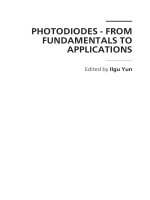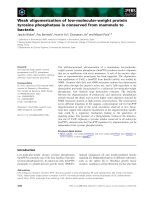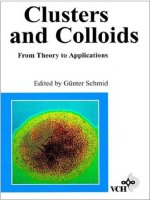PHOTODIODES - FROM FUNDAMENTALS TO APPLICATIONS pot
Bạn đang xem bản rút gọn của tài liệu. Xem và tải ngay bản đầy đủ của tài liệu tại đây (30.09 MB, 376 trang )
PHOTODIODES - FROM
FUNDAMENTALS TO
APPLICATIONS
Edited by Ilgu Yun
Photodiodes - From Fundamentals to Applications
/>Edited by Ilgu Yun
Contributors
Toshiaki Kagawa, Volodymyr Tetyorkin, Andriy Sukach, Andriy Tkachuk, Mikhail Nikitin, Viacheslav Kholodnov,
Fernando de Souza Campos, José Alfredo Covolan Ulson, José Eduardo Cogo Castanho, Paulo Roberto De Aguiar,
Yong-Gang Zhang, Yi Gu, Iftiquar Sk, Lung-Chien Chen, Ana Luz Muñoz, Joaquin Campos Acosta, Alejandro Ferrero
Turrion, Alicia Pons Aglio, Aryan Afzalian, Sergey Dvoretsky, Vladimir Vasilyev, Vasily Varavin, Igor Marchishin, Nikolai
Mikhailov, Alexander Predein, Irina Sabinina, Yuri Sidorov, Alexander Suslyakov, Aleksandr Aseev
Published by InTech
Janeza Trdine 9, 51000 Rijeka, Croatia
Copyright © 2012 InTech
All chapters are Open Access distributed under the Creative Commons Attribution 3.0 license, which allows users to
download, copy and build upon published articles even for commercial purposes, as long as the author and publisher
are properly credited, which ensures maximum dissemination and a wider impact of our publications. After this work
has been published by InTech, authors have the right to republish it, in whole or part, in any publication of which they
are the author, and to make other personal use of the work. Any republication, referencing or personal use of the
work must explicitly identify the original source.
Notice
Statements and opinions expressed in the chapters are these of the individual contributors and not necessarily those
of the editors or publisher. No responsibility is accepted for the accuracy of information contained in the published
chapters. The publisher assumes no responsibility for any damage or injury to persons or property arising out of the
use of any materials, instructions, methods or ideas contained in the book.
Publishing Process Manager Romina Skomersic
Technical Editor InTech DTP team
Cover InTech Design team
First published December, 2012
Printed in Croatia
A free online edition of this book is available at www.intechopen.com
Additional hard copies can be obtained from
Photodiodes - From Fundamentals to Applications, Edited by Ilgu Yun
p. cm.
ISBN 978-953-51-0895-5
free online editions of InTech
Books and Journals can be found at
www.intechopen.com
Contents
Preface VII
Section 1 Fundamental Physics and Physical Design 1
Chapter 1 Two-Photon Absorption in Photodiodes 3
Toshiaki Kagawa
Chapter 2 Physical Design Fundamentals of High-Performance Avalanche
Heterophotodiodes with Separate Absorption and
Multiplication Regions 27
Viacheslav Kholodnov and Mikhail Nikitin
Section 2 Fabrication and Measurements 103
Chapter 3 Fabrication of Crystalline Silicon Solar Cell with Emitter
Diffusion, SiNx Surface Passivation and Screen Printing of
Electrode 105
S. M. Iftiquar, Youngwoo Lee, Minkyu Ju, Nagarajan Balaji, Suresh
Kumar Dhungel and Junsin Yi
Chapter 4 LWIR Photodiodes and Focal Plane Arrays Based on Novel
HgCdTe/CdZnTe/GaAs Heterostructures Grown by MBE
Technique 133
V. V. Vasiliev, V. S. Varavin, S. A. Dvoretsky, I. M. Marchishin, N. N.
Mikhailov, A. V. Predein, I. V. Sabinina, Yu. G. Sidorov, A. O.
Suslyakov and A. L. Aseev
Chapter 5 Photodiodes as Optical Radiation Measurement Standards 173
Ana Luz Muñoz Zurita, Joaquín Campos Acosta, Alejandro Ferrero
Turrión and Alicia Pons Aglio
Section 3 Device Applications 193
Chapter 6 Si-Based ZnO Ultraviolet Photodiodes 195
Lung-Chien Chen
Chapter 7 Infrared Photodiodes on II-VI and III-V Narrow-Gap
Semiconductors 215
Volodymyr Tetyorkin, Andriy Sukach and Andriy Tkachuk
Chapter 8 Al(Ga)InP-GaAs Photodiodes Tailored for Specific
Wavelength Range 261
Yong-gang Zhang and Yi Gu
Chapter 9 Single- and Multiple-Junction p-i-n Type Amorphous Silicon
Solar Cells with p-a-Si1-xCx:H and nc-Si:H Films 289
S. M. Iftiquar, Jeong Chul Lee, Jieun Lee, Juyeon Jang, Yeun-Jung
Lee and Junsin Yi
Section 4 Circuit Applications 313
Chapter 10 Noise Performance of Time-Domain CMOS Image Sensors 315
Fernando de S. Campos, José Alfredo C. Ulson, José Eduardo C.
Castanho and Paulo R. Aguiar
Chapter 11 Design of Multi Gb/s Monolithically Integrated Photodiodes
and Multi-Stage Transimpedance Amplifiers in Thin-Film SOI
CMOS Technology 331
Aryan Afzalian and Denis Flandre
ContentsVI
Preface
This book represents recent progress and development of the photodiodes including the
fundamental reviews and the specific applications developed by the authors themselves.
The key idea of this book is that it allows authors to deal with a wide range of backgrounds
and recent research progresses in photodiode-related areas.
Most of the material in this book was developed for the researchers in the field of optical or
optoelectronic devices and circuits. A substantial proportion of the material is original and
has been prepared by the authors of each book chapter specifically for this book. With re‐
spect to the original collection of the book chapters, this book contains several improve‐
ments and several new problems and related solutions are also discussed in the area of fun‐
damental physics and characteristics, and the device and the circuit applications.
For editing this book, I have assumed that readers are well acquainted with the basic con‐
cepts of semiconductor physics fundamentals, especially with regard to: physical electron‐
ics; electronic materials; semiconductor processes; semiconductor device engineering; elec‐
tronic and optoelectronic circuits, etc.
The book is intended for at least three kinds of readers: a) graduate students of intermediate
and advanced courses in microelectronics or optoelectronics, who are presumed to be most‐
ly interested in photodiode-related applications; b) engineers in the area of optoelectronic
devices, who are especially interested in optical sources and optical detectors; c) professio‐
nal researchers of many areas of applications (not restricted to microelectronics or optoelec‐
tronics or photonics).
This book consists of 4 sections:
Section 1 contains the fundamental concepts of photon absorption in photodiodes. In addi‐
tion, the physical design scheme of the high-performance avalanche heterophotodiodes is
presented to guide the engineers how to design avalanche heterophotodiodes to optimize
their performances in specific applications.
Section 2 contains the fabrication of photodiode-based devices, such as solar cells, photodio‐
des, and focal plane arrays. Especially, the standards of optical radiation measurements us‐
ing photodiodes are also addressed.
Section 3 describes various types of photodiodes as device applications. It includes the ultra-
violet (UV) photodiodes, the infra-red (IR) photodiodes, compound semiconductor photodi‐
odes for specific wavelength, and wide bandgap solar cells.
Section 4 presents the photodiode-related circuit applications. Here, the noise performance
of CMOS image sensor is investigated in time-domain analysis and the high-speed Optoe‐
lectronic Integrated Circuit (OEIC) fabricated by monolithic integration of photodiode and
amplifier is surveyed.
In presenting this book, I would like to express my thanks to the authors who participate in
writing for each book chapter and followed my construct comments, constructive criticism,
and useful suggestions. They include: Toshiaki Kagawa, Viacheslav Kholodnov, Mikhail Ni‐
kitin, Sergey Dvoretsky, S. M. Iftiquar, V.V. Vasiliev, Ana Luz Muñoz Zurita, Lung-Chien
Chen, Volodymyr Tetyorkin, Yong-Gang Zhang, Fernando de S. Campos, Iftiquar Sk, Aryan
Afzalian, and others.
I especially wish to express my sincere thanks to Ms. Romina Skomersic, Publishing Process
Manager in InTech-Open Access Publisher, for the valuable publishing suggestions. More‐
over, I wish to thank the InTech-Open Access Publisher for helping in the typing adjustment
and for revising the English text for each book chapter.
Finally, I would like to thank for my wife, Hyun Jung Cha, and my two adorable sons, Jiho
and Joonho Yun, for their sincere care and support during the whole summer of 2012.
Ilgu Yun
School of Electrical and Electronic Engineering,
Yonsei University
PrefaceVIII
Section 1
Fundamental Physics and Physical Design
Chapter 1
Two-Photon Absorption in Photodiodes
Toshiaki Kagawa
Additional information is available at the end of the chapter
/>1. Introduction
Incident light with a photon energy ℏω induces two-photon absorption (TPA) when
E
g
/
2ℏωE
g
, where E
g
is the band gap of the photo-absorption layer of a photodiode (PD). Be‐
cause the absorption coefficient is small, photocurrent generated by TPA is too low to be
used in conventional optical signal receivers. However, the nonlinear dependence of the
photocurrent on the incident light intensity can be used for optical measurements and opti‐
cal signal processing. It has been used for autocorrelation in pulse shape measurements [1],
dispersion measurements [2,3] and optical clock recovery [4]. These applications exploit the
dependence of the generated photocurrent on the square of the instantaneous optical inten‐
sity. Measurement systems using TPA in a PD can detect rapidly varying optical phenom‐
ena without using high speed electronics.
This chapter reviews research on TPA and its applications at the optical fiber transmission‐
wavelength. Theory of TPA for semiconductors with diamond and zinc-blende crystal struc‐
tures is reviewed. In contrast to linear absorption for which the photon energy exceeds the
band gap, the TPA coefficient depends on the incident lightpolarization. The polarization
dependence is described by the nonlinear susceptibility tensor elements.
The polarization dependences of TPA induced by a single optical beam in GaAs- and Si-PDs
are compared to evaluate the effect of crystal symmetry. It is found that, in contrast to the
GaAs-PD, TPA in the Si-PD is isotropic for linearly polarized light at a wavelength of 1.55
μm. Photocurrents for circularly and elliptically polarized light are also measured. Ratios of
the nonlinear susceptibility tensor elements are deduced from these measurements. The dif‐
ferent isotropic properties of GaAs- and Si-PDs are discussed in terms of the crystal and
band structures.
Cross-TPA between two optical beams is also studied. The absorption coefficient of cross-
TPA strongly depends on the polarizations of the two optical beams. It is shown that the po‐
© 2012 Kagawa; licensee InTech. This is an open access article distributed under the terms of the Creative
Commons Attribution License ( which permits unrestricted use,
distribution, and reproduction in any medium, provided the original work is properly cited.
larization dependence of cross-TPA is consistent with the nonlinear susceptibility tensor
elements obtained from the self-TPA analysis.
Cross-TPA can be applied to polarization measurements. Photocurrents generated in the Si-
PD by cross-TPA between asignal light under test and a reference light are used to detect the
polarization. The light under test is arbitrarily polarized and its Jones vector can be deter‐
mined by photocurrents generated by cross-TPA. This measurement method can detect the
instantaneous polarization when the reference light temporally overlaps with the light un‐
der test. Because the time division is limited only by the pulse width of the reference light, it
is possible to detect rapid variationsin the polarization. This method can measure not only
the linear polarization direction but also the elliptical polarization. Applications to measure‐
ment of the output optical pulse from an optical fiber with birefringence and a semiconduc‐
tor optical amplifier are demonstrated.
2. TPA in semiconductors with diamond and zinc-blende crystals
2.1. Polarization dependence
TPA is a third-order nonlinear optical process. Third order nonlinear polarization is induced
by the optical electric field according to
P
i
(3)
(ω
i
, k
i
)=
1
4
ε
0
∑
j,k,l
χ
ijkl
E
j
(ω
j
, k
j
)E
k
(ω
k
, k
k
)E
l
(ω
l
, k
l
)
(1)
whereε
0
is the permittivity of free space, χ is the third-order tensor, ω is the optical angular
frequency, k is the optical wavenumber vector, E is the optical electric field [5]. The suffixes
i, j, k, and l denote the orthogonal directions. The relationships between the optical angular
frequencies and the wavenumber vectors are determined by energy and momentum conser‐
vation, respectively.
Although the third-order nonlinear susceptibility tensor contains 3
4
elements, the number of
non-zero independent elements is limited by the crystal symmetry and the properties of the
incident light. It is apparent that relations χ
xxxx
= χ
yyyy
= χ
zzzz
and χ
xxyy
= χ
xxzz
= χ
yyzz
, etc. hold
for a cubic crystal. Elements like χ
xxxy
andχ
xxyz
will be zero for crystals with 180° rotational
symmetry about a crystal axis. For degenerate TPA in which one or two parallel optical
beams with the same optical frequency propagate,ω
i
= −ω
j
=ω
k
=ω
l
and χ
xyxy
=χ
xyyx
hold.
There are thus only three independent elements, χ
xxxx
, χ
xxyy
, and χ
xyyx,
for degenerate TPA
in crystal classes of m3m (Si) and 4
¯
3m (GaAs) [5,6].
We consider cross- and self-TPA between two optical beams. The electric field is the sum of
the electric fields of thetwo incident optical beams.
Photodiodes - From Fundamentals to Applications4
E = E
p
p
^
+ E
e
e
^
(2)
where E
p
and E
e
are the electric field strengths andp
^
ande
^
are the polarization unit vectors of
the two beams. For circular or elliptical polarization, p
^
and e
^
are complex to express the
phase difference between the electric field oscillations along two axes. The nonlinear polari‐
zation along the polarization vector p
^
is given by
P
p
(3)
=
1
4
ε
0
(E
p
3
∑
i, j,k,l
p
i
*
p
j
*
p
k
p
l
χ
ijkl
+ 2E
p
E
e
2
∑
i, j,k,l
p
i
*
e
j
*
p
k
e
l
χ
ijkl
)
(3)
wherep
i
and e
i
are elements of p
^
ande
^
, andp
i
*
and e
i
*
are their complex conjugate, respec‐
tively. Because there are only three nonzero independent tensor elements, the nonlinear po‐
larization can be written as [7]
P
p
(3)
=
1
4
ε
0
{
E
p
3
(
|
p
^
⋅ p
^
|
2
⋅χ
xxyy
+ 2χ
xyyx
+ σχ
xxxx
∑
i
|
p
i
|
4
)
+ 2E
p
E
e
2
(χ
xxyy
|
p
^
⋅e
^
|
2
+ χ
xyyx
(1 +
|
p
^
*
⋅e
^
|
2
) + σχ
xxxx
∑
i
|
p
i
|
2
|
e
i
|
2
)
}
(4)
where
σ =
χ
xxxx
−χ
xxyy
−2χ
xyxy
χ
xxxx
(5)
The first and second terms are polarization induced by the self- and cross-electric field
effects, respectively. Terms proportional to the inner product of p
^
and e
^
are invariant for
rotation of axes and are isotropic. In contrast, terms that are proportional to σ vary on the
rotation of the axes. Thus, σ shows the anisotropy of the third-order nonlinear optical
process.
Two optical beams propagate in the crystal under the effect of self- and cross-TPA.
dI
p
dz
= −β
pp
I
p
2
−β
pe
I
p
I
e
(6)
where I
p
and I
e
are optical intensity densities of the two beams. The absorption coefficient is
proportional to the imaginary part of the nonlinear polarization given in Eq. (4).
Two-Photon Absorption in Photodiodes
/>5
β
pp
=
ω
2n
2
c
2
ε
0
(χ
″
xxyy
|
p
^
⋅ p
^
|
2
+ 2χ
″
xyyx
+ σ
″
χ
″
xxxx
∑
i
|
p
i
|
4
)
(7)
and
β
pe
=
ω
n
2
c
2
ε
0
(χ
″
xxyy
|
p
^
⋅e
^
|
2
+ χ
″
xyyx
(1 +
|
p
^
*
⋅e
^
|
2
) + σ
″
χ
″
xxxx
∑
i
|
p
i
|
2
|
e
i
|
2
)
(8)
where n is the refractive index, and c is the speed of light. χ
″
xxxx
etc. are imaginary parts of
the nonlinear susceptibility tensor elements. σ
″
is the anisotropy parameter for imaginary
parts of the nonlinear susceptibility tensor.
σ
″
=
χ
″
xxxx
−χ
″
xxyy
−2χ
″
xyyx
χ
″
xxxx
(9)
2.2. Estimate of photocurrent induced by TPA in PDs
Commercially available PDs are usually designed to be used for photon energies greater
than the band gap of the photoabsorption layer. As the absorption coefficient is about 10
5
cm
-1
, absorption layer is several micrometers thick. On the other hand, the absorption coeffi‐
cient is much smaller for TPA. If we consider only self-TPA, Eq. (6) is solved as
I
p
(z)=
I
0
β
pp
I
0
z + 1
≈I
0
(1−β
pp
I
0
z)
(10)
where I
0
is the initial light intensity density. Using a typical value of 10
-18
m
2
/V
2
for the
imaginary parts of the nonlinear susceptibility tensor elements [7], the TPA coefficient is es‐
timated to be about 6×10
−11
m/W. When the incident light density is 10
7
W/cm
2
, β
pp
I
0
is esti‐
mated to be6×10
−6
μm
-1
. Because only a very small fraction of the incident light is absorbed
in PD with a photo-absorption layer that is several micrometers thick, the induced photocur‐
rent is proportional to the absorption coefficient β.
When optical pulses with an intensity density I
0
and pulse width T
p
are irradiated at a repe‐
tition rate of R, the induced photocurrent will be
J =ηβ
pp
I
0
2
S d T
p
R
q
ℏω
(11)
where η is the internal efficiency of the PD, d is the absorption layer thickness, and S is the
area of the incident beam. The photocurrent is estimated to be about 10
-8
A assuming that
Photodiodes - From Fundamentals to Applications6
the light intensity of 10
7
W/cm
2
is illuminated on a spot with adiameter of 10 μm. We as‐
sume that the pulse width is 1 ps, the repetition rate is 100 MHz, absorption layer thickness
is 2 μm, and the internal efficiency is 1.
3. Experimental setup
Because the photocurrent of PD is proportional to the square of the instantaneous light pow‐
er density, it is necessary to concentrate the optical power into a narrow spatial region and a
short time period. Thus, a short pulsed light beam is more suitable for TPAmeasurements‐
than continuous wave light.
Figure 1 shows the experimental setup. A gain-switched laser diode (LD) generated optical
pulses with a wavelength of 1.55 μm, a pulse width of 50 ps and a repetition rate of 100
MHz. Light pulse from the gain-switched LD exhibit large wavelength chirping. The pulse
was compressed to about 10 ps by an optical fiber with positive wavelength dispersion. Its
peak power was then amplified using an Er-doped fiber amplifier (EDFA) to further com‐
press the pulse width through the nonlinear soliton effect in a normal-dispersion fiber. The
final pulse width was compressed toabout 1 ps.
To measure cross-TPA between two optical beams, a second gain switched LD with a wave‐
length of 1.55 μm was prepared. Noise due to interference between the two beams does not
affect the measurement because the optical frequency difference between the two beams is
greater than the bandwidth of the measurement system. Pulse with a repetition rate of
100MHz are completely synchronized with those of the first optical beam. The second opti‐
cal beam is also amplified by an EDFA.
Both the two beams were made linearly polarized by polarization controllers. After they
were launched into free space, they passed through polarizing beam splitters to ensure that
they were completely linearly polarized. Half-wave or quarter-wave plates were inserted if
it is necessary to control the polarization of the beams. The two beams were spatially over‐
lapped by a polarization-independent beam splitter and they were focused on a PD. It was
confirmed that the polarization did not change on reflection at the polarization-independent
beam splitter by monitoring the polarization before and after reflection. An optical power
meter was placed at the location of the PD and it was used to check if the optical power was
independent of the polarization.
When two optical beams are illuminated on a PD, photocurrents due to self-TPA and cross-
TPAare simultaneously generated. It is necessary to detect only the photocurrent generated
by the cross-TPA. Optical pulse streams were mechanically chopped at frequencies of 1.0
and 1.4 kHz. Electrical pulsesthat had been synchronized with mechanical choppers were
fed into a mixer circuit that generated a sumfrequency of 2.4 kHz. These generated electrical
pulses with the sum frequency were used as the reference signal for the lock-in amplifier.
Thus, the lock-in amplifier detected only the photocurrent generated by two-beam absorp‐
tion, that is, cross TPA.
Two-Photon Absorption in Photodiodes
/>7
Figure 1. Measurement setup (LD: laser diode; NDF: normal dispersion fiber; ADF: abnormal dispersion fiber; PBS: po‐
larization beam splitter; PIBS: polarization independent beam splitter). The inset shows the rotation of the wave plate.
Light from the PBS is linearly polarized along the x axis,which is parallel tothe [1] axis of the PD.
4. Pulse width measurement by cross-TPA
Cross-TPA was used to measure the pulse width generated by the pulse compression proc‐
ess described in the previous section. After the compressed optical pulse was divided into
two branches by an optical fiber beam splitter, the timing between them was controlled by a
variable delay line. They were then irradiated on the Si-PD. The two beams were made or‐
thogonally linearly polarized to suppress noise due to interference. The photocurrent gener‐
ated by cross-TPA between the divided two optical beams is
J (τ)=β
∫
h (t)h (t −τ)dt
(12)
where h(t) is the pulse shape, and τ is the time delay between the two pulses. The pulse
width can be estimated by this self-correlation trace.
Figure 2 shows the self-correlation trace of the compressed optical pulse. The photocurrent
due to the cross-TPA is generated only when the two optical pulses temporally overlap on
the PD. It disappears when the time delay is larger than the pulse width. The self-correlation
trace has a full-width at half-maximum (FWHM) of 1.3 ps. The FWHM of the pulse is esti‐
mated to be about 0.9 ps assuming a Gaussian pulse shape.
5. Polarization dependence of self-TPA in Si- and GaAs-PDs
Measuring the photocurrent generated in PDs is the easiest way to study the polarization
dependence of self-TPA coefficient. Because the fraction of the incident photons that are ab‐
Photodiodes - From Fundamentals to Applications8
sorbed is quite small, the generated photocurrent is directly proportional to the absorption
coefficientβ
pp
as shown by Eq. (10). The photocurrents generated in Si- and GaAs-PDs were
compared to discuss the polarization dependence of TPA in Si and GaAscrystals[8].
Figure 2. Self-correlation trace of the compressed pulse measured by TPA of Si-PD.
In the self-TPA measurement, only one optical beam is illuminated on a PD. The optical
beam with a pulse width of 0.9 ps in the measurement setup described in section 3was used
in the self-TPAmeasurement. The x- and y- axes are fixed in the laboratory frame. We con‐
sider the case when light that is linearly polarized alongthe x-axis is transformed by a half-
or quarter-wave plate. The principal axis of the wave plate is rotated at an angle of θ relative
to the x-axis. The polarization of the transformed light is expressedby
p
^
=
(
p
x
p
y
)
=
(
cosθ −sinθ
sinθ cosθ
)
(
1 0
0
e
iφ
)
(
cosθ sinθ
−sinθ cosθ
)(
1
0
)
(13)
where ϕ=π and π/2 for half- and quarter-wave plates, respectively. The inset of Fig. 1 shows
the definition of the rotation angle. The principal axes of the quarter-wave plate are repre‐
sented by the X- and Y-axes. The phase of the polarization component along the Y-axis is
delayed by ϕ relative to that along the X-axis.
The anisotropy of self-TPA for linearly polarized light was measured for Si- and GaAs-PDs.
The crystal axis [001] is made parallel to the x-axis. The linear polarization is rotated by a
half-wave plate (i.e., ϕ=π in Eq. (13)). When the X-axis is tilted by an angle of θ relative to
the x-axis, the polarization direction of the output light from the half-wave plate is tilted by
Two-Photon Absorption in Photodiodes
/>9
2θ. Thus, the polarization is parallel to the [001] and [011] directions when the rotation angle
of the half-wave plate is θ = 0 and 22.5° , respectively. Using Eq. (7), the anisotropy parame‐
ter σ" defined by Eq. (9) can be written as
σ
″
=2
β
pp
L
001 −β
pp
L
011
β
pp
L
001
(14)
Figure 3. Photo currents generated when linearly polarized lightirradiated on (a) GaAs PD and (b) Si PD. The linear
polarization direction is rotated using a half-wave plate. The horizontal axis is the tilt angle of the half wave plate.The
solid lines in (a) and (b) show the values calculated using Eq. (15) with σ" = –0.45 and 0, respectively.
whereβ
pp
L
001 and β
pp
L
011 are the TPA coefficients for linearly polarized light polarized
along the [001] and [011] directions, respectively.This parameter can be experimentallydeter‐
mined by the ratio of photocurrents.
Figures 3(a) and (b) respectively show the photocurrents generated in GaAs- and Si-PD sas a
function of the rotation angle of the half-wave plate. For the GaAs-PD, the photocurrent var‐
ies with the polarization direction indicating that the TPA is anisotropic. The anisotropy pa‐
rameter σ'' is estimated to be –0.45. From Eqs. (7), (9) and (13), the dependence of the TPA
probability on the rotation angle θof the half-wave plate can be written as
β
pp
L
∝
1
4
χ
″
xxxx
(4−σ
″
+ σ
″
cos8θ)
(15)
The solid line in Fig. 3 (a) shows the value calculated using Eq. (15) and σ''= –0.45. In con‐
trast, the Si-PD exhibits negligibly small dependence on the polarization direction and the
TPA coefficient is almost isotropic;
|
σ
″
|
is estimated to be less than 0.04.
Figure 4(a) and (b) respectively shows the dependence of the photocurrents generated in the
GaAs- and Si-PDs on the rotation angle of a quarter-wave plate (ϕ=π/2in Eq. (13)). The inci‐
dent light is linearly polarized along the [001] direction and circularly polarized at θ = 0 and
Photodiodes - From Fundamentals to Applications10
45° , respectively. The difference in the self-TPA coefficients for linear and circular polariza‐
tion isexpressed by the dichroism parameter
δ =
β
pp
L
001 −β
pp
C
β
pp
L
001
=
χ"
xxxx
+ χ"
xxyy
−2χ"
xyyx
2χ"
xxxx
(16)
whereβ
pp
C
is the TPA coefficient for circularly polarized light. This parameter is estimated to
be 0.1 and 0.39 from the measured photocurrents for linearly and circularly polarized light
in the GaAs- and Si-PD, respectively.
Figure 4. Photocurrent obtained when elliptically polarized light is incident on (a) GaAs and (b) Si PDs. Linearly polar‐
ized light along the [001] axis is transformed by a quarter-wave plate rotated at an angle of θ.The solid lines indicate
the results calculated using Eq. (17) and the parameters in Table 1.
The ratios χ ''
xxyy
/ χ ''
xxxx
and χ ''
xyyx
/ χ ''
xxxx
can be estimated from measured anisotropic
and dichroism parameters. Table 1 lists the obtained ratios for the nonlinear susceptibility
tensor elements for GaAs and Si.
From Eqs. (7), (9), (13) and (16), the dependence of the TPA coefficient on the quarter-wave
plate rotation angle θ is given by
β
pp
∝
1
16
χ
″
xxxx
(16−σ
″
−8δ + σ
″
cos8θ + 8δcos4θ)
(17)
This self-TPA coefficient is maximized when
cos
2
2θ = −
χ"
xxyy
χ"
xxxx
1
σ
″
(18)
The absorption coefficient for this elliptically polarized light is greater thanβ
L
001 .
Two-Photon Absorption in Photodiodes
/>11
The solid lines in Figs. 4(a) and (b) show the results calculated using Eq. (17) for GaAs and
Si, respectively. The photocurrent shown in Fig. 4(a) reaches a maximum at θ = 15° , which
indicates that Eq. (18) holds at this angle. The factor χ"
xxyy
/
(σ
″
χ"
xxxx
)in Eq. (18) is estimat‐
ed to be –0.75 for GaAs. This value is consistent with the values of σ
″
andχ
″
xxyy
/
χ
″
xxxx
in Ta‐
ble 1, indicating that thepolarization dependence of the GaAs-PD is consistent with the
analysis based on the nonlinear susceptibility.
On the other hand, the photocurrent generated in the Si-PD is maximized when the an‐
gle is 0 and the incident light is linearly polarized, which contrasts the situation for the
GaAs PD. Because the anisotropy parameter is small, Eq. (18) does not hold at any rota‐
tion angle θ.
6. Discussion of self-TPA polarization dependence
The polarization dependence of self-TPA is strongly dependent on the crystal symmetry and
the band structure. Hutchings and Wherettcalculated nonlinear susceptibility tensor ele‐
ments based on kp perturbation [9]. The ratios listed in Table 1 are consistent with their re‐
sults. Murayamaand Nakayama[10] have performed ab initio calculations.Their calculated
values for the ratiosχ"
xxyy
/ χ"
xxxx
andχ"
xyyx
/ χ"
xxxx
depend on the photon energy. The val‐
ues of ratios shown in Table 1 are very similar to those calculated for a photon energy of 1
eV. The small discrepancy between the photon energies is probably due to the parameters
used in the calculation.
GaAs Si
Anisotropy parameter σ" -0.45
|
σ
″
|
<0.04
Dichroism parameter δ 0.1 0.39
χ"
xxyy
/ χ"
xxxx
0.34 0.39
χ"
xyyx
/ χ"
xxxx
0.56 0.31
Table 1. Parameters obtained from the polarization dependence of the photocurrents of GaAs and Si PDs at a
wavelength of 1.55 μm.
It is very reasonable that GaAs and Si were observed to have quite different anisotropies be‐
cause of their different crystal symmetries and band structures. As GaAs has a direct transi‐
tion type band structure, an optical transition occurs at around the Γ point. The anisotropy
for GaAs is due to the allowed–allowed transition [7,9] (see Fig. 5(a)), which is the two-step
optical transition ofΓ
15v
→Γ
15c
→Γ
1c
. Γ
15v
, Γ
1c
, and Γ
15c
are irreducible representations of the
point group T
d
(4
¯
3m) of the GaAs crystal for the highest valence band, the lowest conduction
band, and the higher conduction band at the Γ point, respectively [11]. The first transition
Γ
15v
→Γ
15c
occurs between p-like states, the second transition Γ
15c
→Γ
1c
occurs between p-like
Photodiodes - From Fundamentals to Applications12
and s-like states. The polarization directions that induce the first and second transitions
must be different from each other. For example, transitions
|
p
z
(Γ
15v
) →
|
p
x
(Γ
15c
) and
|
p
x
(Γ
15c
) →
|
s(Γ
1c
) are induced by dipole moments polarized along they- and x-axes, re‐
spectively.
|
p
z
(Γ
15v
) ,
|
p
x
(Γ
15c
) ,and
|
s(Γ
1c
) are wave functions of each band [11]. This proc‐
ess does not contribute to χ
″
xxxx
andχ
″
xxyy
, but it contributes to χ
″
xyyx
causing the anisotropy
parameter σ’’ to be non-zero [7]. The matrix element of the optical dipole moment between
Γ
15v
and Γ
15c
is non-zero because T
d
lacks space inversion symmetry.
On the other hand, Si has the indirect transition type band structure. Figure 5(b) schemati‐
cally shows the band structure and the irreducible representation of this space group [11,12].
A photon energy of 0.8 eV is too small to induce a direct TPA transition without phonon
absorption or emission at any point in the first Brillouin zone of Si. The final sate of the TPA
transition is Δ
1
, which has the minimum energy of the conduction band. Many complicated
transitionsequences that include optical and phonon transitions exist to reach the final point
Δ
1
for electron.
When both optical transitions occur at Γ point, an electron is scattered to Δ
1
in the conduction
band. However, two step optical transitions in Si are quite different from that in GaAs. Si
crystal has a point group of O
h
(m3m) that has space inversion symmetry and the wavefunc‐
tion is an eigenstate of the parity at the Γ point. The matrix elements of the dipole moment
between the conduction bands of Γ
15
, Γ
2'
, and Γ
12'
vanish because they all have the same pari‐
ty. The only possible virtual final state of the two-step optical transition sequence in Γ point
is Γ
1
in the higher conduction band. AsΓ
1
has a much greater energy than Γ
25'
andΔ
1
, the tran‐
sition probability is thought quite small.
Figure 5. a) Schematic band structure and allowed–allowed transition in GaAs. (b) Schematic band structure of Si
Two-Photon Absorption in Photodiodes
/>13
When a phonon process occurs after the first optical transition, the polarization effect of the
first optical transition on the intermediate state of TPA can be destroyed by the phonon
process. The anisotropy is thus considered to be reduced by this process.
7. Cross-TPA in Si-APD
As shown in the previous section, TPA in Si is isotropic. Thus, TPA in Si-PD is simpler than
that in GaAs-PD. In addition, a Si avalanche photodiode (APD) with the multiplication gain
is commercially available. Consequently, we concentrate on cross-TPA in Si-APD.
Cross-TPA depends on the relationship between the polarization vectors of the two beams.
We measure three cases: when both beams are linearly polarized, when one optical beam is
linearly polarized and the other is varied between linear, elliptical, and circular polarization
by a quarter-wave plate, and when one beam is circularly polarized and the other is varied
between linear, elliptical, and circular polarization [13].
Figure 6. Photocurrent due to cross- TPA between two linearly polarized beams. Solid line is the calculated results
using parameters in Table 1.
Figure 6 shows the photocurrent when both beams are linearly polarized. The horizon‐
tal axis of the figure is the rotation angle of the half- wave plate. The photocurrent was
Photodiodes - From Fundamentals to Applications14
normalized using the minimum photocurrent. The photocurrent is strongly dependent on
the orientation of the two linear polarization axes and has a maximum and minimum
values when the polarization axes of the two optical pulses are parallel and perpendicu‐
lar, respectively.
Equation (8) can be written as
β
pe
∝
1
2
(χ
″
xxyy
+ χ
″
xyyx
) cos4θ +
1
2
(χ
″
xxyy
+ 3χ
″
xyyx
)
(19)
The solid line in Fig.6 shows the result calculated using Eq. (19) and the parameters in Table 1.
The absorption coefficient hasa maximum and minimum whenp
^
and e
^
are parallel and or‐
thogonal, respectively. The ratio of the maximum to minimum values is
β
pe
(p
^
/ /
e
^
)
β
pe
(p
^
⊥e
^
)
=2 +
χ
″
xxyy
χ
″
xyyx
(20)
Using the parameters in Table 1 which were obtained from the self-TPA of Si, this ratio is
3.26. This value is consistent with the measured cross-TPA shown in Fig 6
Figure 7. Photocurrent due to cross-TPA between linear polarized and elliptical polarized lights. Solid line is the calcu‐
lated results using parameters in Table 1.
Two-Photon Absorption in Photodiodes
/>15
Figure 7 shows the photocurrent when one beam (e
^
) was linearly polarized and the polari‐
zation of the other beam (p
^
) was varied using a quarter-wave plate. The horizontal axis is
the rotation angle of the quarter-wave plate. The polarization of the second beam varied be‐
tween linear, elliptical, and circular in this case. The solid line shows the calculated value
using the parameters in Table 1. The photocurrent had maximum and minimum values
when the second beam was linearly and circularly polarized, respectively. The ratios are
theoretically written as
β
pe
(p
^
/ /
e
^
)
β
pe
(p
^
;circular)
=
4 + 2χ
″
xxyy
/
χ
″
xyyx
3 + χ
″
xxyy
/
χ
″
xyyx
(21)
using Eq (8). This ratio is calculated to be 1.53 from the parameters in Table 1, and is consis‐
tent with the measurement.
Figure 8 shows the photocurrent when one beam was circularly polarized while the polari‐
zation of the other beam was varied using a quarter-wave plate between linear, elliptical,
and circular polarization. The unit vectors for circular polarization are σ
^
+
=
1
2
(x
^
+ iy
^
)and
σ
^
−
=
1
2
(x
^
−i y
^
). An arbitrary polarization vector p
^
can be written as a linear combination of
these unit vectors.
p
^
= p
+
σ
^
+
+ p
−
σ
^
−
(22)
Whene
^
=σ
^
−
, Eq (8) can be written as
β
pe
∝χ
″
xxyy
|
p
+
|
2
+ χ
″
xyyx
(1 +
|
p
−
|
2
). (23)
We used the relations σ
^
+
⋅σ
^
−
=1andσ
^
+
⋅σ
^
+
=σ
^
−
⋅σ
^
−
=0. β
pe
is independent of p
^
when
χ"
xxyy
=χ"
xyyx
because
|
p
+
|
2
+
|
p
−
|
2
=1.The photocurrent depends on the polarization, as
Fig. 8 shows, but this dependence is relatively small.
The dependence of the absorption coefficient on the rotation angle is
β
pe
∝
(
χ
″
xxyy
−χ
″
xyyx
)
sin2θ + χ
″
xxyy
+ 3χ
″
xyyx
(24)
The ratio of the maximum tominimum values is
β
pe
(p
^
=σ
^
+
)
β
pe
(p
^
=σ
^
−
)
=
1
2
(1 +
χ
″
xxyy
χ
″
xyyx
)
(25)
It is estimated to be 1.13 using the parameters in Table 1.
Photodiodes - From Fundamentals to Applications16
Figure 8. Photocurrent due to cross TPA when one optical beam is circularly polarized.
The solid line in Fig. 8 is the calculated results using Eq. (24). When one optical beam is cir‐
cularly polarized, cross-TPA exhibits very weak dependences on the polarization of the oth‐
er optical beam because values of χ
″
xxyy
and χ
″
xyyx
are very close to each other: however, in
principle, they are not exactly equal for Si.
The calculated values shown by the solid lines in Figs. 6, 7, and 8 are obtained by nonlinear
susceptibility tensor elements that were deduced from the polarization dependence of self-
TPA. There is relatively good agreement with the measured cross-TPA. This demonstrates
that the polarization dependences of self- and cross-TPA of Si are consistent with theoretical
analysis based on the nonlinear susceptibility tensor.
8. Polarization measurement by cross-TPA
The polarization dependence of the cross-TPA in Si-APD can be used to measure the polari‐
zation. In this method, a Si-APD is irradiated by the arbitrarily polarized light to be meas‐
ured (signal light) and a linearly polarized referencebeam. The photocurrents generated by
cross-TPA between the signal light and the linearly polarized reference light are measured.
Polarization direction of the reference beam was varied in four ways. Polarization of the
arbitrarily polarized light can be determined from the four photocurrents of the APD [14].
Several applications require the ability to detect rapid variations in the polarization of an
optical signal. In all conventional polarization measurement methods, the temporal resolu‐
Two-Photon Absorption in Photodiodes
/>17









